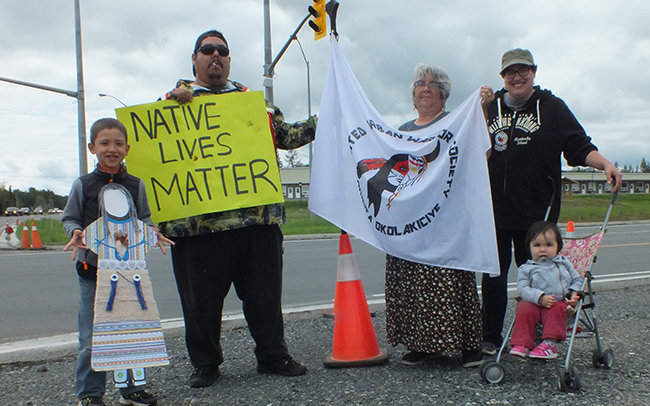United Urban Warriors Society protests lagging nation inquiry on Murdered and Missing Indigenous Women and Girls

By Leslie Knibbs
The United Urban Warriors Society (UUWS) held a demonstration on Aug.19 on the Trans-Canada Highway at Highway Six and 17 to protest their disappointment and frustration with the way the National Inquiry on Murdered and Missing Indigenous Women and Girls (MMIWG) is working – or not working, according to Izzy Pangowish, Canadian Chapter spokesperson for the UUWS, “the inquiry has failed many families who have been waiting for a very long time [to participate with their stories].”
The Inquiry’s original mandate was to study the cases of more than 1,200 missing and murdered women and girls from First Nations across Canada, together with the 18 that went missing from the Trans-Canada Highway.
“We never thought we would be back out here for the MMIWG, however, it is quite disappointing since the inquiry started, over 60 families are on the waiting list to make presentations and only a few of the families have been selected,” said Pangowish. “Apparently 1.5 Million dollars was spent for MMIWG staff payroll.”
Pangowish wondered why there was a payroll before the Inquiry started—”Why does anyone have to be paid?”. The Inquiry has a budget of $41 million.
Pangowish along with other members of the group carried the Eagle Staff into the middle of the Trans-Canada holding signs and placards showing their frustration with the Inquiry’s progress, or according Pangowish, their “lack of progress”. Traffic was stopped while Pangowish performed a drum song and other protesters joined in dancing in a circle.
“Our missing mothers/sisters and daughters are missing at the hands of our own government system. For this Inquiry to reboot we need First Nation Leaders to take full control of the Inquiry….I’d like to see Regional Chief and Union of Ontario Indians chiefs and other First Nation leaders to have sole control of this Inquiry – we are holding our own Governments and RCMP and some local authorities accountable.”
During the protest, many pictures of missing women were posted on a red background and placed on signs and a pole in the area. A makeshift memorial of a red dress was hanging throughout the protest signifying the absence and missing Indigenous women and girls.
Pangowish believes the only way the Inquiry will work is to put Indigenous People in charge, and, to include all of those wanting to tell their stories. “I’m disappointed with the Inquiry, as are most First Nation Chiefs.” At a recent meeting of Chiefs in Regina, many expressed their discontent with how the Inquiry was going according to Pangowish. He pointed to the resignations within the Inquiry staff as an indicator it is not working.
“Dragging their feet is what they are doing,” said Pangowish. “We Anishnaabe people are the ones who need to interview Governments and Police in an Inquiry about our MMIWG.”
While taking a coffee break, Pangowish related the story of one mother who travelled to the Inquiry in Winnipeg to tell the story of her missing daughter. Bernice Cathaway, her husband and son came from Portage la Prairie, Manitoba to speak, telling the inquiry about the long delay in police investigating her daughter’s disappearance after she reported it. She told the Inquiry an RCMP officer advised her that her daughter Jennifer would eventually come home. According to Cathaway, in the nine years since she reported her daughter missing, neither she nor her family received a single phone call from the police investigating her daughter’s disappearance. Like other First Nation people, Cathaway strongly suggested the police should be held accountable. At the inquiry, Cathaway’s husband spoke of how he and other family members did their own search–dragging the river from canoes. He pointed out that less than two months after the family’s search began, a white girl went missing and part of the river was diverted to make searching more thorough. According to reports, over 1500 people took part in the search for the white girl. Hearing this powerful story, Pangowish made the call out to members to have the Aug. 19 demonstration.
With stories like this rumbling through many First Nation communities, Pangowish and the UUWS are not alone in wanting an Inquiry into police practices during the Inquiry on MMIWG. With the Inquiry stalled at this time, Pangowish and others in the UUWS as well as community members across the country feel the investigation is ‘stuck in the mud’ and going nowhere. The original Terms of Reference for the Inquiry indicate the police are not to be held accountable; however, days after Cathaway’s pleas, the inquiry issued a press release stating, “The National Inquiry can and will consider the conduct of policing services and policies across Canada in 14 Federal, Provincial and Territorial jurisdictions.”
The envisioned aims of both the MMIWG National Inquiry and First Nations are on different trajectories looking for resolutions. Pangowish suggests there is resistance on the government’s side to alter present governmental systems in vogue between other nations; however, First Nations are looking for a new path with direct participation involving their leadership as well as community members in determining the course of the Inquiry. Finding reconciliation and resolutions on matters like the National Inquiry on MMIWG is not a simple task.
The demonstration included citizens from Manitoulin Island, Serpent River First Nation, Wikwemikong, and other communities along the North Shore.


